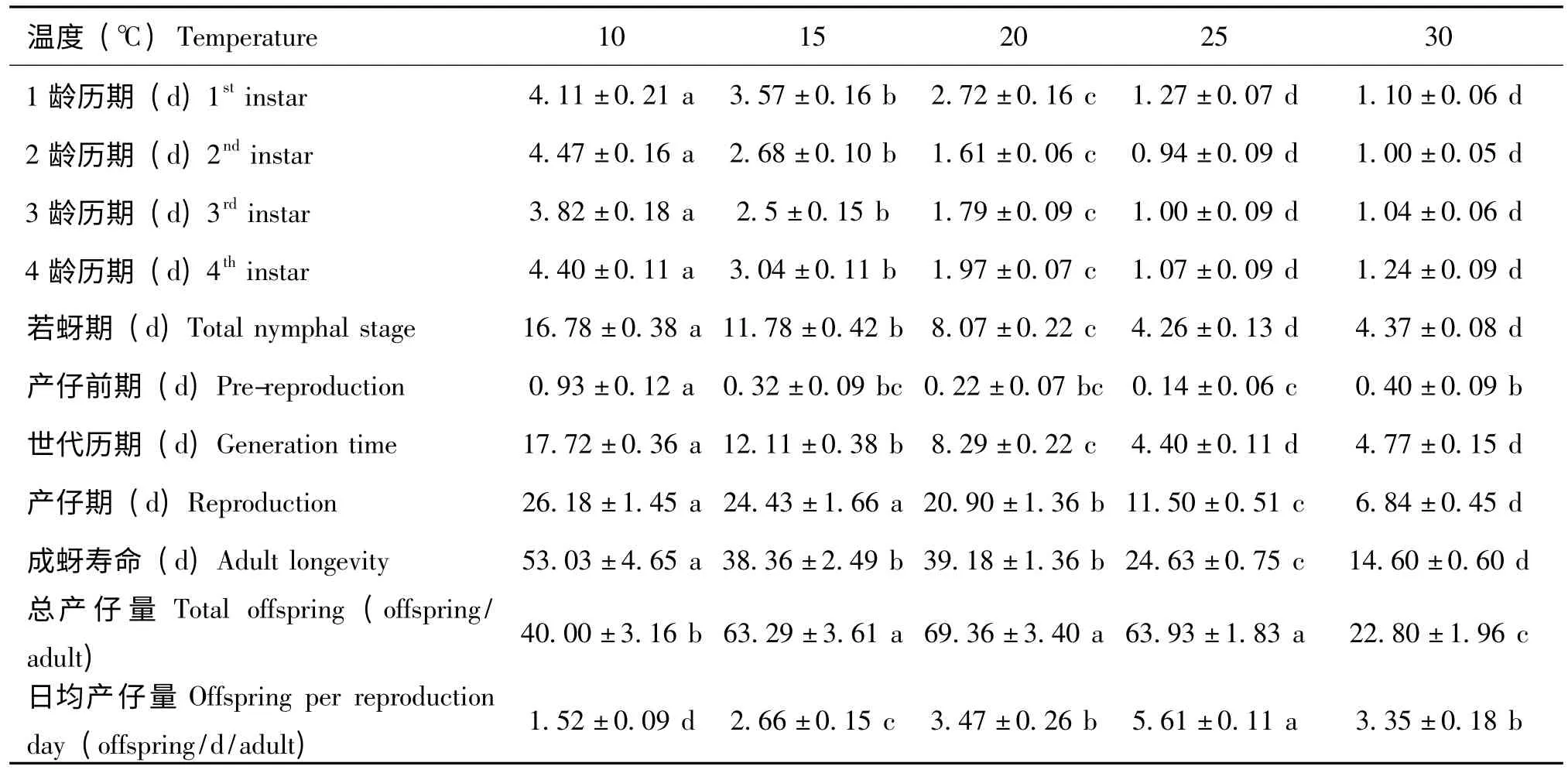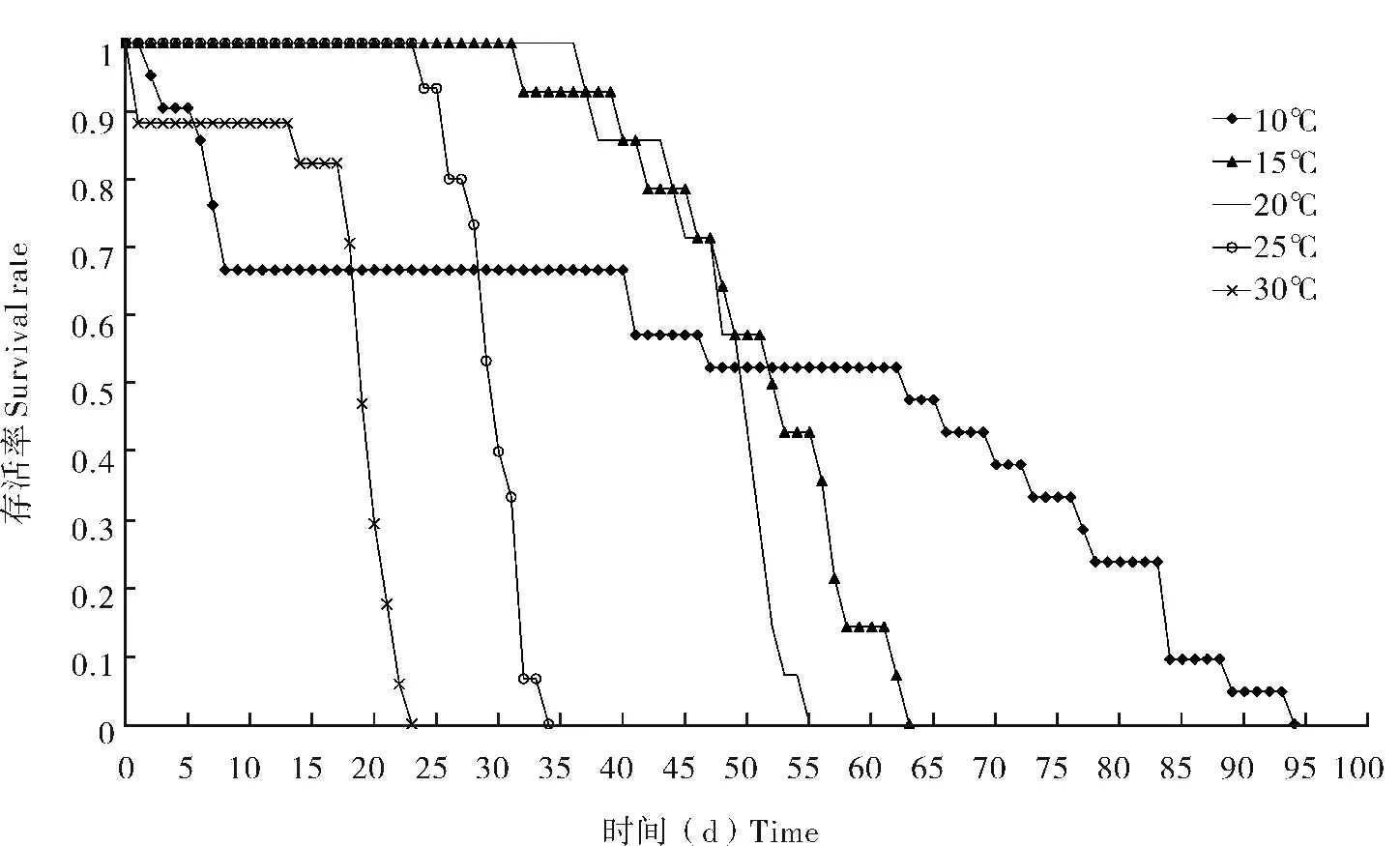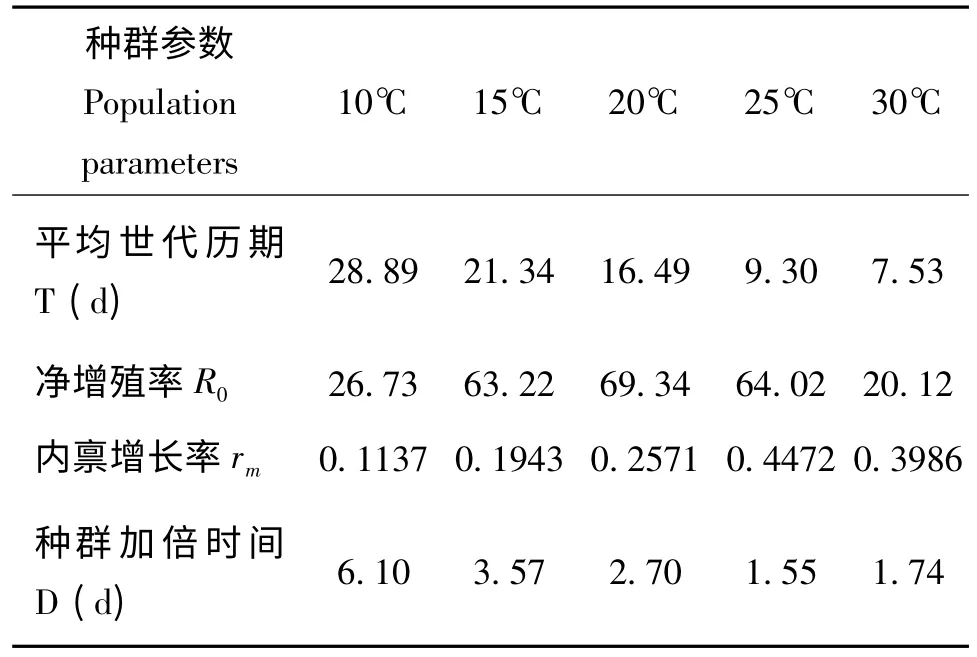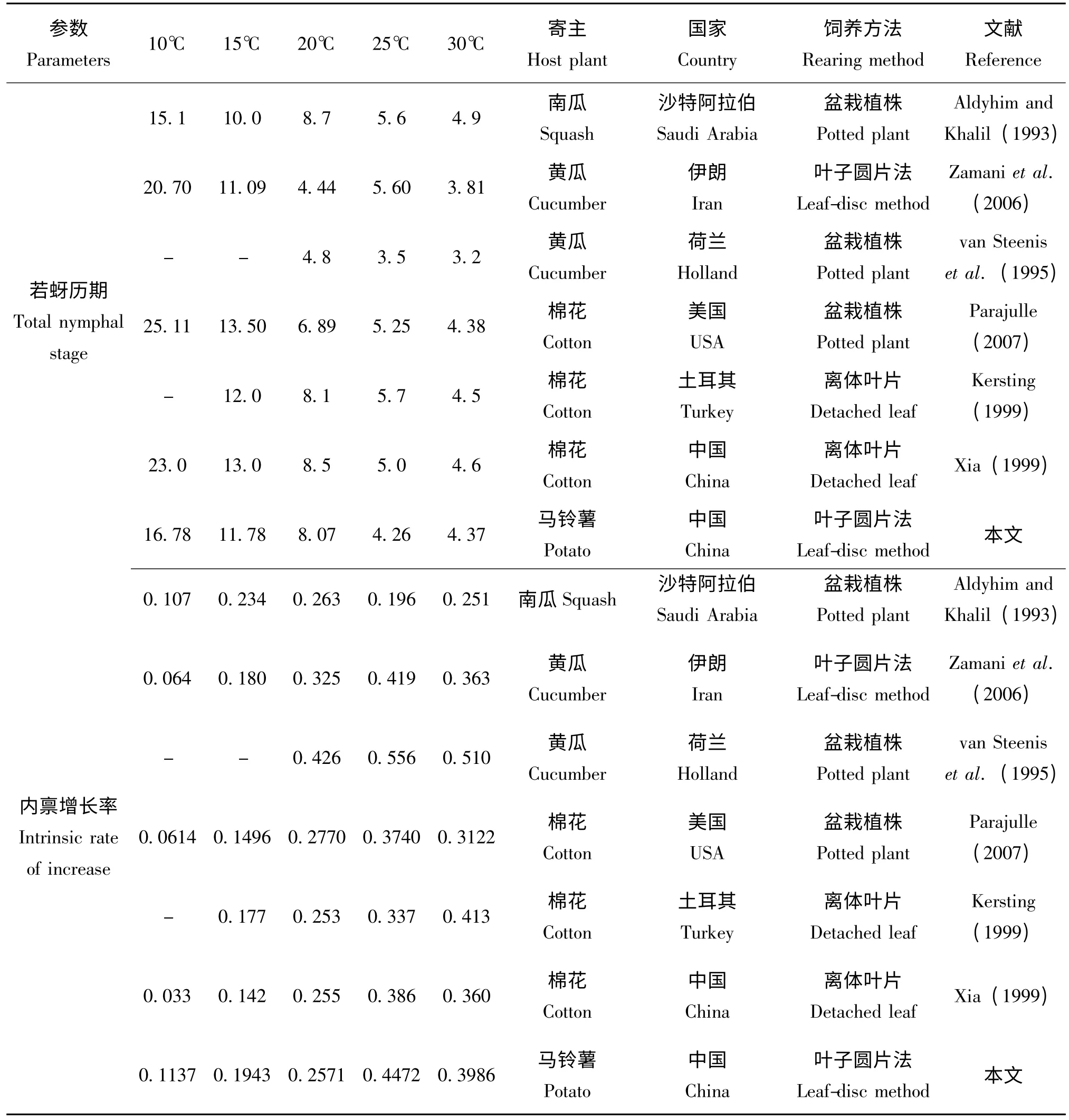温度对马铃薯棉蚜生长发育及种群增长的影响
2015-12-09周晓榕卜庆国庞保平
周晓榕,卜庆国,庞保平
(内蒙古农业大学农学院,呼和浩特 010019)
棉蚜Aphis gossypii Glover 又称瓜蚜,广泛分布于热带、亚热带和温带地区,是棉花、瓜类等农作物的重要害虫(Kersting et al.,1999)。温度是调节昆虫种群动态、发育速率和季节发生的关键因子。关于温度与棉蚜生长发育及种群增长的关系已有大量的研究,主要集中于棉花(吴孔明和刘芹轩,1992;Kersting et al.,1999;Xia et al.,1999;刘向东,2000;刘健等,2003;Parajulee,2007;苗伟等,2008)、瓜类作(Aldyhim and Khalil,1993;Kocourek et al.,1994;van Steenis et al.,1995;庞保平等,1999;周琼等,2002;Zamani et al.,2006) 及柑橘(Komazaki,1982)。马铃薯营养价值高、产量高、用途广、适应性强,已成为世界上仅次于水稻、小麦的第三大粮食作物。蚜虫是马铃薯上常见的害虫,不仅直接影响马铃薯的产量和品质,而且是传播马铃薯病毒的主要昆虫媒介。在内蒙古、宁夏、黑龙江等我国马铃薯主产区,棉蚜是发生数量和范围仅次于桃蚜Myzus persicae 的马铃薯蚜虫(周艳丽和杨骥,2004;董风林等,2010;卜庆国等,2013)。然而,有关马铃薯上棉蚜的生物学特性却了解的很少。因此,作者研究了温度对棉蚜在马铃薯上的生长发育及种群增长的影响,以期为马铃薯蚜虫的监测预警提供必要的基础。
1 材料与方法
1.1 供试虫源
从内蒙古大学内蒙古马铃薯工程技术研究中心农场马铃薯田采回棉蚜,接种于盆栽马铃薯苗上繁殖3 代以上作为供试虫源。
1.2 实验方法
参考刘树生(1987)的新叶圆片法,取一透明饮料瓶,剪去上部圆锥部分,保留底部圆柱部分。将一马铃薯叶片(品种为费乌瑞特)叶面朝下用1%琼脂糖凝胶粘在塑料瓶底部,在其上放置1 头12 h 内产出的1 龄无翅若蚜,瓶口处用橡皮筋将黑色(便于观察脱皮情况)塑料薄膜覆盖固定,将瓶底部朝上放于人工气候箱中,每12 h 观察记录蚜虫的蜕皮、生殖、死亡情况。设置10、15、20、25 和30℃等5 个温度处理,光照16L∶8D,相对湿度60%±10%。每个温度处理设30 个重复。
1.3 数据分析
根据有效积温法则R=(T-C)/K,计算马铃薯棉蚜的发育起点温度(C)和有效积温(K);根据实验数据组建马铃薯蚜虫实验种群生命表,计算平均世代历期(T)、净增值率(R0)、内禀增长率(rm)和种群加倍时间(D)等生命表参数(丁岩钦,1994)。存活曲线应用Weibull 分布进行拟合(Pinder,1978),公式为:存活率Sp (t)=exp[-(t/b)c],t 、b、c >0,其中b 为尺度参数,c 为形状参数。当c >1 时,存活曲线为Ⅰ型;当c=1 时,存活曲线为Ⅱ型;当c<1 时,存活曲线为III 型。如果c 值相同,b 值越大,存活率越高。
应用DPS 9.5 数据处理系统进行统计分析,不同处理之间的差异比较采用ANOVA 法,多重比较采用LSD 法。
2 结果与分析
2.1 温度对棉蚜生长发育及生殖力的影响
从表1 可知,温度对棉蚜在马铃薯上的发育历期和生殖力具有显著的影响 (P<0.05)。在10℃-25℃范围内,各龄发育历期、若蚜期、世代历期均随温度的升高而缩短,处理间差异显著,但在25℃与30℃下的差异不显著。随着温度从10℃上升到30℃,成蚜产仔期和寿命分别从26.18 d 和53.03 d 缩短至6.84 d 和14.6 d,处理间差异显著(P<0.05)。棉蚜总产仔量在15℃-25℃时最高,与其它处理差异显著(P<0.05),其次为10℃,30℃时最低。日均产仔量在25℃时最高,与其它处理差异显著(P<0.05),其次为20℃和30℃,最低为10℃。上述结果说明,25℃最适合于棉蚜的生长发育和繁殖,10℃的低温和30℃的高温均不利于棉蚜在马铃薯上生长发育和繁殖。
2.2 棉蚜的发育起点温度和有效积温
线性模型很好地描述了温度与马铃薯棉蚜不同发育阶段发育速率的关系(表2)。1 龄若蚜发育起点温度最高(5.93℃),3 龄最低(4.09℃)。4 龄若蚜有效积温最大(28.36 日度),2 龄若蚜最小(22.29 日度)。完成1 个世代需要的有效积温为110.84 日度,发育起点温度为4.56℃。

表1 不同温度下马铃薯棉蚜的发育历期和生殖力Table 1 Developmental duration and fecundity of Aphis gossypii reared on potato at different temperatures (mean±SE)

表2 马铃薯棉蚜的发育起点温度和有效积温Table 2 Lower developmental threshold and thermal constant of Aphis gossypii reared on potato
2.3 不同温度下棉蚜的存活曲线
从表3 可知,在10℃条件下,马铃薯棉蚜存活曲线c 值约等于1,说明在10℃的低温条件下,棉蚜存活曲线为II 型存活曲线,即棉蚜各发育阶段的死亡率基本相同(图1)。在15℃-30℃范围内,c 值均远远大于1,说明在此温度范围内,棉蚜的存活曲线为I 型存活曲线,即死亡主要发生在生活史的后期(图1)。在15℃-25℃范围内,棉蚜若蚜期存活率最高,其次为30℃,最低为10℃。利用存活曲线的参数估计,棉蚜在马铃薯上的适宜存活温度为15℃-25℃。

表3 不同温度下马铃薯棉蚜存活曲线的参数估计Table 3 Parameter estimation on survival curves of Aphis gossypii reared on potato at different temperatures (mean±SE)

图1 不同温度下马铃薯棉蚜的存活曲线Fig.1 Survival curves of Aphis gossypii reared on potato at different temperatures
2.4 温度对棉蚜种群生命表参数的影响
从表4 可知,棉蚜平均世代历期随温度上升而缩短,从10℃时的28.89 d 缩短至30℃时的7.53 d。在15℃-25℃时,净增值率(63.22-69.34)远高于10℃ (26.73)及30℃ (20.12)时的净增值率。内禀增长率在25℃时最大;虽然30℃时净增值率最小,但由于此温度下发育速率最快,其内禀增长率仅次于25℃;再次为20℃;10℃时,内禀增长率最低,仅为0.1137。在25℃时,种群增长1 倍仅需1.55 d,而10℃时,需要6.10 d。利用种群生命表参数研究表明,马铃薯棉蚜种群增长的最适温度为25℃,其次为30℃,再次为20℃,最次为10℃。

表4 不同温度下马铃薯棉蚜种群生命表参数Table 4 Life table parameters of Aphis gossypii populations reared on potato at different temperatures
3 结论与讨论
国内外研究表明温度对棉蚜生长发育、存活和繁殖有显著的影响,但不同地理种群和寄主作物下的发育历期和内禀增长率等种群参数差异较大(表5)。本文结果表明,棉蚜在马铃薯上的最适发育温度为25℃,与吴孔明和刘芹轩(1992)的结果相近(26℃),但低于大多数的研究结果(30℃) (Aldyhim and Khalil,1993;Kocourek et al.,1994;van Steenis et al.,1995;Kersting et al.,1999 ;庞保平等,1999;Xia et al.,1999;刘向东等,2000;Parajulee,2007;苗伟等,2008)。棉蚜在马铃薯上种群增长最快的(rm最大)温度也为25℃,与Aldyhim 和Khalil (1993)、van Steenis 和 El-Khawass (1995)、Xia 等(1999)、Zamani 等(2006)及Parajulee (2007)的结果相同,但低于Kersting 等(1999)、吴孔明和刘芹轩 (1992)和Kocourek 等 (1994)的30℃,高于Komazaki (1982)的19.8℃。从表5可以看出,在相同的温度下,黄瓜上棉蚜若蚜的发育速率快于棉花上的棉蚜;在10℃的低温下,黄瓜和棉花上棉蚜的发育历期远长于南瓜和马铃薯上棉蚜的发育历期。在相同的温度下,不同地区和寄主上棉蚜的内禀增长率存在一定的差异。造成差异的原因可能与地理种群和寄主植物不同有关,也可能与研究方法不同有关。在寄主植物和温度相同的条件下,棉蚜的发育速率和内禀增长率在盆栽植株叶片上通常高于离体叶片上,可能是离体叶片营养条件较差或机械损伤产生诱导抗性(李艳艳等,2013),抑制了棉蚜的生长发育。另一方面,本文马铃薯上棉蚜的发育起点温度和有效积温分别为4.56℃和110.84 日度,与同一地区黄瓜上棉蚜的非常接近(4.52℃和120.23日度) (庞保平等,1999),低于其它地区棉花上(6.2℃-7.1℃)(Kersting et al.,1999;Xia et al.,1999;Parajulee,2007) 和黄瓜 (6.19℃)(Zamani et al.,2006)的发育起点温度,但远高于柑橘上(-0.4℃)(Komazaki,1982)的发育起点温度;有效积温略高于Kersting 等 (1999)的108.9 日度、Zamani 等(2006)的97.09 日度和Kocourek 等(1994)的90.1 日度,但低于Xia 等(1999)的168.8 日度和Komazaki (1982)的181.8 日度。综上所述,棉蚜对温度的生理响应与寄主植物和地理种群有关。

表5 国内外对棉蚜生长发育研究的比较Table 5 Comparison of studies on the growth and development of Aphis gossypii
References)
Aldyhim YN,Khalil AF.Influence of temperature and day length on population development of Aphis gossypii on Cucumber pepo[J].Entomologia Experimentalis et Applicata,1993,67:167-172.
Bu QG,Pang BP,Zhang RF,et al.Population dynamics of aphids in potato fields in Hohhot,Inner Mongolia[J].Chinese Journal of Ecology,2013,32 (1):135-141.[卜庆国,庞保平,张若芳,等.呼和浩特地区马铃薯田蚜虫的种群动态[J].生态学杂志,2013,32 (1):135-141]
Ding YQ.Insect Mathematical Ecology [M].Beijing:Science Press,1994.[丁岩钦.昆虫数学生态学[M].北京:科学出版社,1994]
Dong FL,Liu BY,Jin JL,et al.Study on spatial and temporal dynamics of aphid population on potato in Guyuan [J].Gansu Agricultural Science and Technology,2010,3:12-14.[董风林,刘秉义,靳军良,等.固原马铃薯蚜虫种群空间和时间动态的研究[J].甘肃农业科技,2010,3:12-14]
Kersting U,Sater S,Uygun N.Effect of temperature on development rate and fecundity of apterous Aphis gossypii Glover (Hom.,Aphididae)reared on Gossypium hirsutum L.[J].Journal of Applied Entomology,1999,123:23-27.
Kocourek F,Havelka J,Berakova J,et al.Effect of temperature on development rate and intrinsic rate of increase of Aphis gossypii reared on greenhouse cucumber[J].Entomologia Experimentalis et Applicata,1994,71:59-64.
Komazaki S.Effect of constant temperature on population growth of three aphid species,Toxoptera citricidus (Kirkaldy),Aphis citricola van der Goot and Aphis gossypii Glover (Hom.,Aphididae)on citrus[J].Applied Entomology and Zoology,1982,17:75-81.
Li YY,Zhou XR,Pang BP,et al.Influences of Aphis gossypii Glover feeding on the content of main nutrients and secondary compounds in host plants [J].Journal of Environmental Entomology,2013,35 (1):45-54.[李艳艳,周晓榕,庞保平,等.瓜蚜为害对寄主植物主要营养物质和次生物质的影响[J].环境昆虫学报,2013,35 (1):45-54]
Liu J,Wu KM,Zhao KJ,et al.The ecological adaptability of Aphis gossypii collected from different climate zones to temperature and photoperiod[J].Acta Ecologica Sinica,2003,23 (5):863-869.[刘健,吴孔明,赵奎军,等.不同气候带棉蚜对温度和光周期的生态适应[J].生态学报,2003,23 (5):863-869]
Liu SS.A leaf-disc method for rearing aphids[J].Chinese Bulletin of Entomology,1987,24 (2):98,113-115.[刘树生.介绍一种蚜虫饲养的方法—新的叶子圆片法[J].昆虫知识,1987,24 (2):98,113-115]
Liu XD,Zhang XX,Zhao NS,et al.Ecological adaptation of Aphisgossypii (Homoptera:Aphididae)to cotton developmental stage and temperature[J].Journal of Nanjing Agricultural University,2000,23 (4):29-32.[刘向东,张孝羲,赵娜珊,等.棉蚜对棉花发育阶段和温度的生态适应[J].南京农业大学学报,2000,23 (4):29-32]
Miao W,Lv ZZ,Yu JN,et al.Effect of temperature on development and fecundity of cotton aphid (Aphis gossypii)[J].Xinjiang Agricultural Sciences,2008,45 (6):1130-1135.[苗伟,吕昭智,于江南,等.温度对棉蚜发育与存活的影响[J].新疆农业科学,2008,45 (6):1130-1135]
Pang BP,Guan MZ,Hao SG,et al.The fecundity tables and effective accumulative temperature for experimental population of cucumber aphid,Aphis gossypii Glover in plastic shed[J].Journal of Inner Mongolia Agricultural University,1999,20 (4):36-38.[庞保平,关明卓,郝树广,等.保护地瓜蚜实验种群生殖力表和有效积温[J].内蒙古农业大学学报,1999,20 (4):36-38]
Parajulee MN.Influence of constant temperatures on life history parameters of the cotton aphid,Aphis gossypii,infesting cotton[J].Environmental Entomology,2007,6 (4):666-672.
Pinder JE.The Weibull distribution:A new method of summarizing survivorship data[J].Ecology,1978,59 (5):175-179.
van Steenis MJ,El Khawass Kamh.Life history of Aphis gossypii on cucumber:Influence of temperature,host plant and parasitism[J].Entomologia Experimentalis et Applicata,1995,76:121-131.
Wu KM,Liu QX.Influence of temperatures on population increase of cotton aphid Aphis gossypii [J].Acta Gossypii Sinica,1992,4 (1):61-68.[吴孔明,刘芹轩.温度对棉蚜种群增长的影响[J].棉花学报,1992,4 (1):61-68]
Xia JY,van der Werf W,Rabbinge R.Influence of temperature on bionomics of cotton aphid Aphis gossypii on cotton[J].Entomologia Experimentalis et Applicata,1999,90:25-35.
Zamani AA,Talebi AA,Fathipour Y,et al.Effect of temperature on biology and population growth parameters of Aphis gossypii Glover(Hom.,Aphididae)on greenhouse cucumber [J].Journal of Applied Entomology,2006,130:453-460.
Zhou Q,Liang GW,Cen YJ.The influence of temperature and host plants on the experimental population of Aphis gossypii Glover[J].Journal of South China Agricultural University,2002,23 (1):31-34,37.[周琼,梁广文,岑伊静.温度和寄主植物对瓜蚜实验种群的影响[J].华南农业大学学报,2002,23 (1):31-34,37]
Zhou YL,Yang J.Quantitative change of aphids with wings in potato[J].China Potato,2004,18 (5):267-269.[周艳丽,杨骥.马铃薯有翅蚜的数量动态[J].中国马铃薯,2004,18 (5):267-269]
